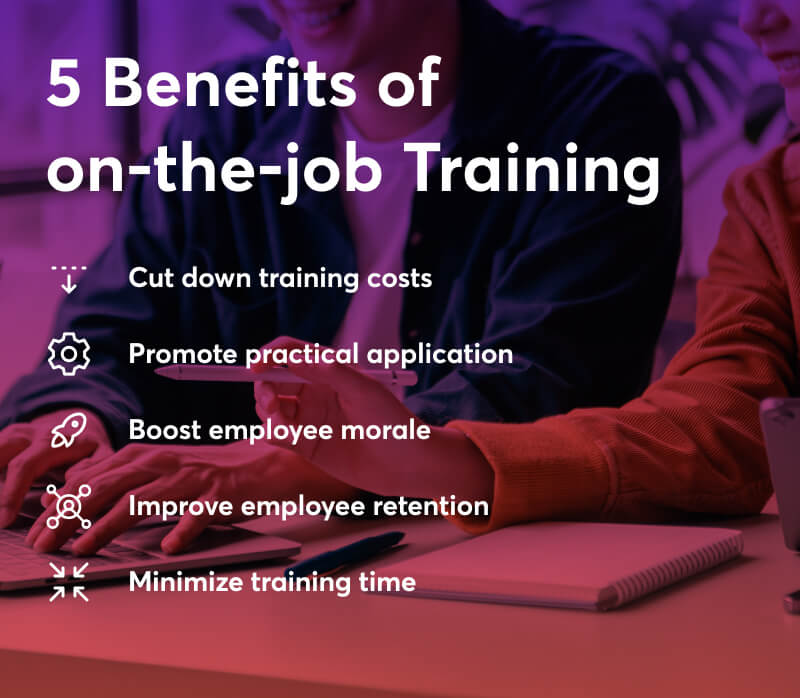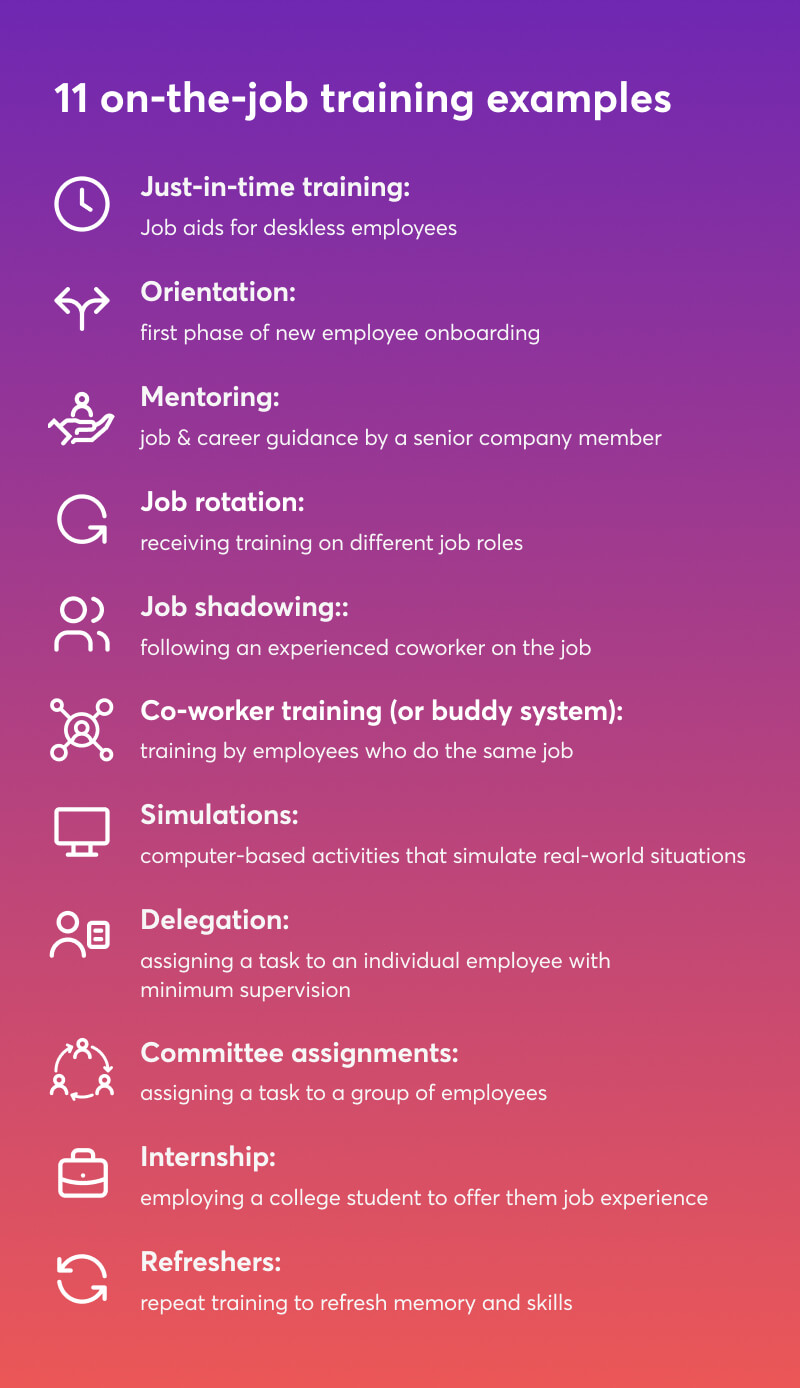Table of Contents
On-the-job training (also referred to as OJT) is an indispensable part of new employee onboarding and employee upskilling programs. Being synonymous with hands-on learning, on-the-job is the type of training that helps employees “get their hands” dirty and actually practice as they’re learning new skills or refreshing existing ones.
Learning by doing is extremely efficient in instilling knowledge and translating this knowledge into practical application.
Due to its hands-on nature, on-the-job training is mostly linked to technical skills and practical tasks – operating machinery, using workplace tools, performing job tasks, following procedures, and so on. But that doesn’t mean it doesn’t apply to soft skills training.
Many on-the-job training examples improve valuable soft skills like communication, team building, and emotional intelligence.
If you want to know more about this type of employee training, you’re in the right place. In this post, we’re sharing 11 top examples of on-the-job training and strategies to implement it. But first, let’s see what makes this training method so effective.
9000+ brands trust LearnWorlds to train their people, partners & customers.
Start a FREE Trial5 Big-Time Benefits of an On-The-Job Training Program
Should you use on-the-job training in your organization? We believe so, and we have 5 good reasons that will make you see the point in it as well:

Cut down on training costs
More often than not, you will not need extra resources to train the employee the same way you would for a traditional training program that involves seminars. That said, it’s advisable to keep a central repository with all necessary instructions and practical information.
Promote practical application
At the end of the day, the proof is in the pudding – and the “pudding” is whether employees can actually do what the training promises. On-the-job training helps achieve that by being activity-focused and providing hands-on experience.
Employees learn by observing, asking, doing, and receiving feedback in real time. This way, they reach the learning objectives of the course faster and more effectively. Not to mention, that the need for assessment is virtually eliminated since their knowledge is tested and proved during the training.
Boost employee morale
On-the-job training is the best way to help new and seasoned employees become more productive and perform better, as it provides opportunities to apply what is taught on the spot.
Passive learning, like attending seminars and watching video lectures, can be discouraging and even boring. Actually doing something, however, reinforces the sense of accomplishment and makes the employee feel useful.
Improve employee retention
On-the-job training is the most effective training method for onboarding, since new hires need to adjust to a new work environment as well as to their new role. Pairing them with an experienced employee is an excellent way to introduce them to the company culture, help them acclimate, and form stronger bonds among colleagues, all of which play a massive role in improving employee retention.
Minimize training time
Practice speeds up the learning process. It helps the employee internalize the new knowledge and cultivate skills and competencies faster by building “muscle memory” instead of relying on memorization. With on-the-job training, employees learn faster and better.
11 Effective On-the-Job Training Examples
Hands-on training can be a very effective way to train employees. There are several on-the-job training methods to help cultivate the necessary skills and improve employee performance that may or may not involve formal training sessions. Which one’s the best? Well, there’s no right or wrong here. It all depends on your specific training needs and the human resources available.
Let’s go over some of the most popular and effective on-the-job training examples:

1
Orientation
Orientation is the initial phase of employee onboarding and it typically lasts between a few hours to a full work day. Orientation is not about developing a new skill set, so it doesn’t involve any formal training sessions; it’s about introducing the new employee to their team members and getting them acquainted with key tasks of their new job. During orientation, the new hire also learns about organizational structure and company policies and receives practical information about office operations.
2
Just-in-Time Training
Just-in-time training (JIT) refers to training not only on the job – but also on the point of need and not before. Rather than formal employee training, JIT is more of a job aid, and it’s particularly beneficial for deskless employees, like salespeople, healthcare professionals, and field workers, who don’t have easy access to a laptop.
To deliver just-in-time training, you’ll need a Learning Management System with a mobile app, like LearnWorlds, so that the content is optimized for mobile consumption. You’ll also need to create bite-size content that employes can easily consume, also known as microlearning content. Common examples include infographics and short videos.
💁LearnWorlds is an excellent LMS solution both for employee onboarding and just-in-time training (and much more!). Launch your own branded mobile app, create interactive content, and streamline training using with our customizable platform. Discover LearnWorlds with a 30-day free trial today!
9000+ brands trust LearnWorlds to train their people, partners & customers.
Start a FREE Trial3
Coaching & Mentoring
Coaching and mentoring are effective types of on-the-job training that can be conducted either online or in person and involve pairing the employee with an experienced, usually senior, company employee. These methods are the most supportive. Although the terms are often used interchangeably, they are slightly different.
Coaching focuses on unlocking the employee’s potential and helping them overcome roadblocks to meet their professional goals. In many cases, coaching is done by an external professional. Mentoring is more focused on assisting the employee to master their new job role and discuss career goals with the mentor sharing advice and offering guidance. Depending on the employee needs, you can opt for one or the other.
4
Job rotation
Another method of on-the-job training is job rotation, which involves training employees in different jobs, usually similar to what they’re already doing. Job rotation doesn’t aim to improve their skill set but to increase transparency and help employees understand how the work of other employees is linked to their own. This type of training might even help employees discover they fit better in a role they hadn’t originally planned.
5
Job shadowing
Job shadowing is a common type of on-the-job training where the trainee follows an experienced coworker on a typical workday (or more). This gives them ample opportunity to ask questions in real-time as they arise and better comprehend the task at hand. Job shadowing is extremely effective and can cut down the duration of the OJT program.
6
Co-worker training
Perhaps the most common type of on-the-job training, co-worker training (or buddy system) refers to pairing an employee with a colleague who does the same job. Every employee has their own approach, so the training process might differ.
Some may focus on doing practical tasks together, while others might additionally offer resources like documentation they have prepared for personal use. The buddy system uses knowledge sharing as it’s primary learning method and it fosters strong employee relationships.
7
Simulations
Simulations imitate real-life situations and are particularly effective because they require the employee to think and act on the spot, often under critical circumstances. They are very common in types of training where employees run higher risks and benefit from practicing in a safe environment, like health, safety, compliance, and even cybersecurity.
Simulations are computer-based and are usually part of formal training courses that involve several synchronous training sessions and self-paced learning. They’re used either to assess employee knowledge or promote practical application.
8
Delegation
Delegation is when a manager assigns a task to a trainee and asks them to complete it, usually with minimum supervision. Delegation can be tricky, as it requires the manager to effectively gauge the competency level of the trainee and assign them a task that challenges them just the right amount; they should be able to complete it, but at the same time, it shouldn’t be too easy.
9
Committee assignments
This type of OJT is like delegation but on a larger scale: a manager or supervisor forms a group of employees (a committee) and assigns them a project. Usually, the project is intricate and requires that the employees collaborate effectively to finish it.
Being essentially group assignments, committee assignments are excellent team-building activities that enhance communication and collaboration skills and reinforce team spirit as well as any job-specific skills.
10
Internship
An internship refers to “hiring” a college student so they can get work experience while they’re still studying. An internship is a valuable and highly sought-after type of on-the-job training that offers students a head start in the job market as they have experience their fellows don’t. Internship positions may or may not be paid. An internship can also lead to a permanent job for the intern.
11
Refreshers
Refresher training refers to on-the-job training that aims to freshen up existing knowledge through active recall and practical application. An often overlooked type of training, refreshers help keep employee skills sharp and current, as this training is usually updated to meet the latest job requirements.
Quick Tips & Strategies for On-the-job Training Success
Are you considering deploying on-the-job training? We have some words of advice for you for successful implementation.
On-The-Job Training is the Missing Piece of Employee L&D
No matter your industry, there’s always room for on-the-job training in a business. If you want to train employees fast and effectively, this is the single best way to ensure they are able to apply knowledge and skills on the job, and get the work done effectively.
Likewise, a Learning Management System is the missing tool in your training toolkit. It will help you keep all essential learning material in one place, allow learners to learn at their own pace, offer employees job aids when they need them, and streamline training for everyone.
Do you want to see for yourself? Sign up for a 30-day free trial with LearnWorlds now!
9000+ brands trust LearnWorlds to train their people, partners & customers.
Start a FREE TrialFurther reading you might find interesting:

Androniki Koumadoraki
Androniki is a Content Writer at LearnWorlds sharing Instructional Design and marketing tips. With solid experience in B2B writing and technical translation, she is passionate about learning and spreading knowledge. She is also an aspiring yogi, a book nerd, and a talented transponster.



